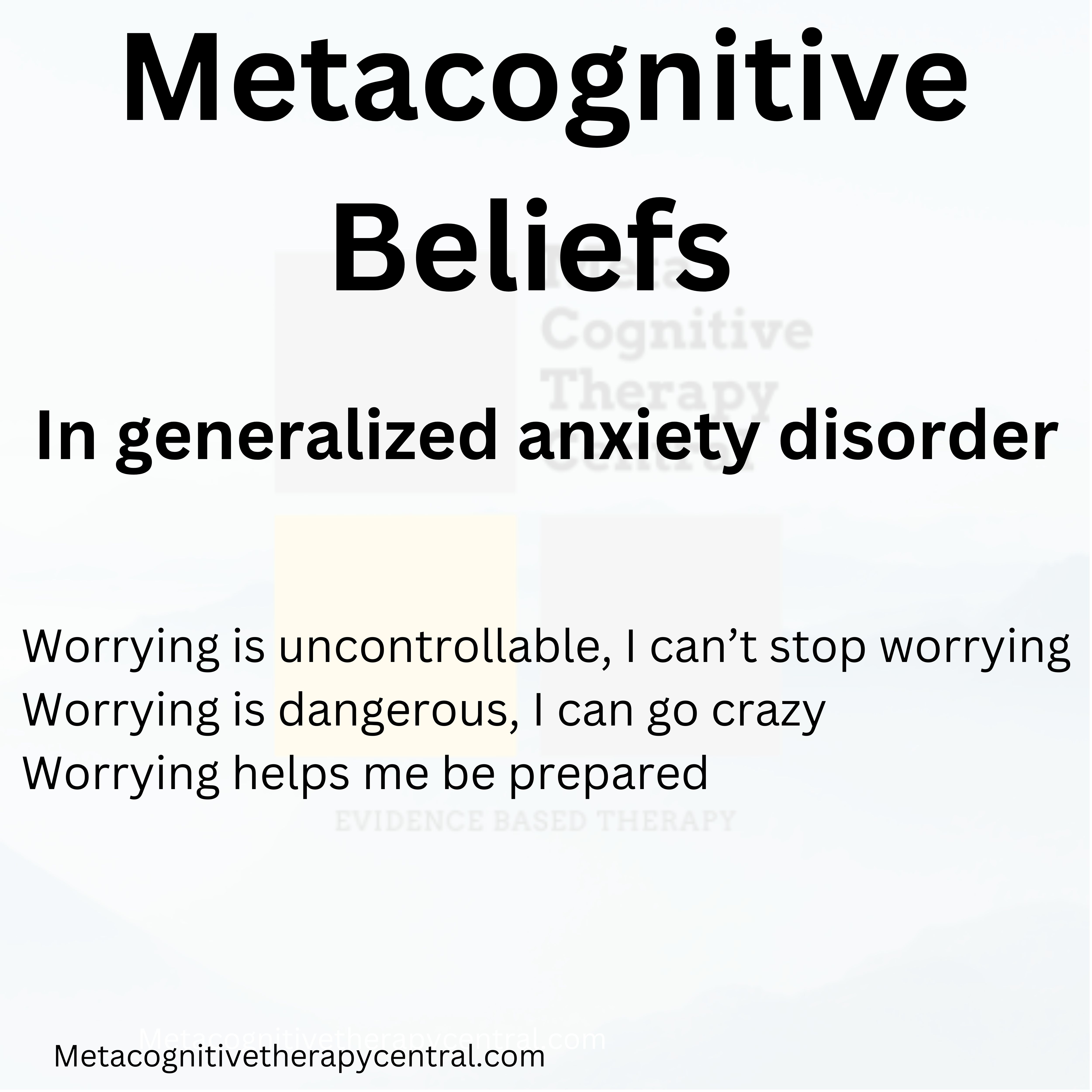
Trait anxiety (which is the proneness to reacting with anxiety under stressful situations) has in the past been linked to psychological disorders. Trait anxiety impacts personal well-being, and relationship satisfaction, and can lead to social and work impairment. However, research on trait anxiety only vaguely explains how it leads to developing anxiety disorder.
The metacognitive model of anxiety describes that worrying and misconceptions about worrying in the form of metacognitive beliefs, are the root cause of anxiety disorders. Since metacognitive beliefs activate worrying, unmodified metacognitive beliefs lead to developing anxiety disorders.
How metacognitive beliefs about worrying cause anxiety
Since worrying is the core feature of anxiety disorders, worrying in metacognitive theory is seen as an active way of coping with threats.
Worrying is activated by positive metacognitive beliefs and sustained by negative metacognitive beliefs.
A positive metacognitive belief about worrying tells you that worrying is a good idea because worrying will help you prepare for the future and solve your problems.
A negative metacognitive belief about worrying tells you that once you start worrying, you can’t stop and that worrying will harm your mind and body.
When people start to worry and don’t get to a solution right away, they begin to experience anxiety symptoms. These symptoms, in turn, activate negative metacognitive beliefs like:
I have no control over my worrying
My worries have taken control over me
Believing in the above metacognitive beliefs makes it harder even to try to stop worrying. Therefore, once negative metacognitive beliefs are activated, people continue to worry and therefore experience more symptoms.

How worrying starts
Worrying is your go-to strategy whenever it comes to dealing with life. People prone to developing generalized anxiety disorder believe greatly in worrying as a way to problem-solve. Superstitious reasons for worrying are also drivers of worry (something bad will happen if I don’t worry at all).
Examples of what people think about worrying as a problem-solving strategy:
Worrying helps me cope
Worrying keeps me in control
If I worry, I can anticipate and avoid problems
On the surface, these beliefs seem reasonable, but they are the reason why people start worrying in the first place, increasing the risk of people falling into the anxiety cycle. These beliefs are also the reason people experience relapse into anxiety (because they still view worrying as helpful and even necessary, and therefore continue to worry).
Persistent worrying activates anxiety symptoms
How worrying leads to more worrying
Worrying about worrying is called meta-worry or type 2 worry in Metacognitive therapy. Examples of type 2 worry are:
“I am losing control”
“If I continue to worry like this I will go crazy or harm my body”
Worrying for a long time activates symptoms of anxiety, which in turn activates worrying about worrying. This is because people misinterpret their anxiety symptoms and believe that they are about to have a heart attack or lose control over themselves.
Anxiety symptoms are misinterpreted as dangerous, and worrying is seen as damaging, which leads to more worry (4).
The more you think that worrying is outside of your control, the more you worry.

How worrying lead to using unhelpful coping
If you don’t believe that you can stop worrying or event think that worrying is dangerous, you might use other strategies to stop it. Usually, these strategies are unhelpful. Example unhelpful coping behaviors are seeking reassurance, googling information, using distractions, drinking alcohol, checking, and avoiding situations.
For example, some people seek reassurance from their partners and families in order to stop worrying. One client used to share her worry with her husband so that he could tell her there was nothing to worry about. However, seeking reassurance prevented her from learning that she was able to stop worrying on her own.
Coping behaviors are unhelpful because:
1) coping behaviors make you hand over control to external factors
2) coping behaviors prevent you from discovering that worrying does not lead to dangerous outcomes like a heart attack or a mental breakdown
3) coping behaviors are short-term solutions. They may work momentarily, but only until the next time you start worrying again
Unhelpful coping behaviors are used in an attempt to stop worrying
Thought control startegies
If you don’t believe that you can stop worrying, you probably also try to control the thoughts that you worry about.
Controlling thoughts usually happens through
- worry
- punishment
- thought suppression
While worry is persistent thinking about what-if questions, punishment uses negative thoughts, minor pain, or anger to control thoughts (for example by telling yourself that something bad will happen if you continue to think a specific thought).
Many people worry and use thought control strategies from time to time. However, what distinguishes people with Generalized anxiety disorder is that they ALWAYS use thought control strategies. Their way of dealing with negative thoughts becomes inflexible because it relies on thought control instead of reducing worry in the first place (3).
It is important to understand that thought control strategies are only helpful in the short term (that is if you succeed in making it work). Usually, thought control strategies require a lot of attention and effort that could be used elsewhere, and often they don’t work.
If you are not convinced, try not to think of a giraffe for two minutes.

Thought control strategies prevent the brain from healthy emotional processing, which means that trying to get rid of negative thoughts only prolongs them.
Thought control = thought suppression, punishment for thinking specific thoughts, and worrying to stop thinking
Research on the role of metacognitive beliefs in anxiety
Research shows that negative metacognitive beliefs are strongly associated with pathological worrying. A study from 1997 (1) compared patients with generalized anxiety disorder (GAD) to patients with other anxiety disorders. The study found that people with GAD had higher levels of negative metacognitive beliefs (that on a scale from 0-100%, people believed almost 100% that they couldn’t stop worrying even if they wanted to).
This study from 2001 (2) compared patients with GAD against patients with social phobia, panic disorder, and people not suffering from anxiety. They found out that the GAD group could be distinguished from the other groups because they believed more in the uncontrollability and danger of worrying. They also confirmed that people with GAD had a higher need for controlling their thoughts in fear of the consequences of not doing so (“Some thoughts can make me lose my mind”).

Can anxiety be prevented?
Since the metacognitive model of anxiety disorders clearly shows how anxiety develops, it can also help us learn how to effectively prevent it.
Here are some questions you can ask yourself to help increase your awareness and detect if you are using some or all of the above strategies that lead to anxiety.
Persistent worry inevitably activates anxiety symptoms like tension, stress, trembling, and mind racing. These symptoms make you worry even more and you could end up getting an anxiety disorder. If you suffer from an anxiety disorder, seeking professional help is important to help you break free from the worry cycle and challenge your metacognitive beliefs correctly.
Am I worrying a lot?
Sometimes, my clients are not aware of how much time they spend worrying and overthinking. They have somehow gotten used to being in a worry mode, and although stressful, they think this is normal.
So the first question you can ask yourself is whether you spend a lot of time worrying without noticing it.
TIP: It is important to learn that there are other ways to solve problems and prepare for challenging situations instead of worrying. For example, setting time aside for preparation and problem-solving is a better alternative to worry. Not only will this reduce your worrying tremendously, but it will also sharpen your problem-solving skills. After all, your brain will be better equipped to solve problems when it isn’t stressed from all the worrying.
Am I using unhelpful coping to stop worrying?
Now that you know the negative consequences of using coping behaviors, why not stop it altogether?
For example, if you always seek reassurance to help you stop worrying, try instead to postpone asking for reassurance until you get to your worry time. It is a good way to find out that you have complete control over worrying.
TIP: Do you really think that worrying is out of your control? Think about situations where you were able to stop worrying without using any distractions. You will be surprised to find out how much control you really have
Summary
- Metacognition (metacognitive beliefs) can cause anxiety because they make you start worrying.
- Worrying lead to anxiety symptoms.
- Worrying also leads to more worrying, which in MCT is called meta-worry.
- People who don’t believe they can stop worrying use destructive coping behaviors like thought suppression, reassurance seeking, and some even self-harm.
- Metacognitive therapy is the only treatment that effectively deals with metacognitive beliefs and ensures that people stay recovered in the long term.

References
- Cartwright-Hatton S, Wells A. Beliefs about worry and intrusions: the Meta-Cognitions Questionnaire and its correlates. J Anxiety Disord. 1997 May-Jun;11(3):279-96. doi: 10.1016/s0887-6185(97)00011-x. PMID: 9220301.
- Wells A. Metacognitive Theory and Therapy for Worry and Generalized Anxiety Disorder: Review and Status. Journal of Experimental Psychopathology. 2010;1(1). doi:10.5127/jep.007910
- Nordahl, H.; Hjemdal, O.; Hagen, R.; Nordahl, H.M.; Wells, A. (2019) What lies beneath trait-anxiety? Testing the Self-Regulatory Executive Function Model of vulnerability. Frontiers in Psychology
- Nordahl, H.M.; Borkovec, T.D.; Hagen, R.; Kennair, L.E.O; Hjemdal, O.; Solem, S. (2018) Metacognitive therapy versus cognitive–behavioural therapy in adults with generalised anxiety disorder. BJPsych Open



